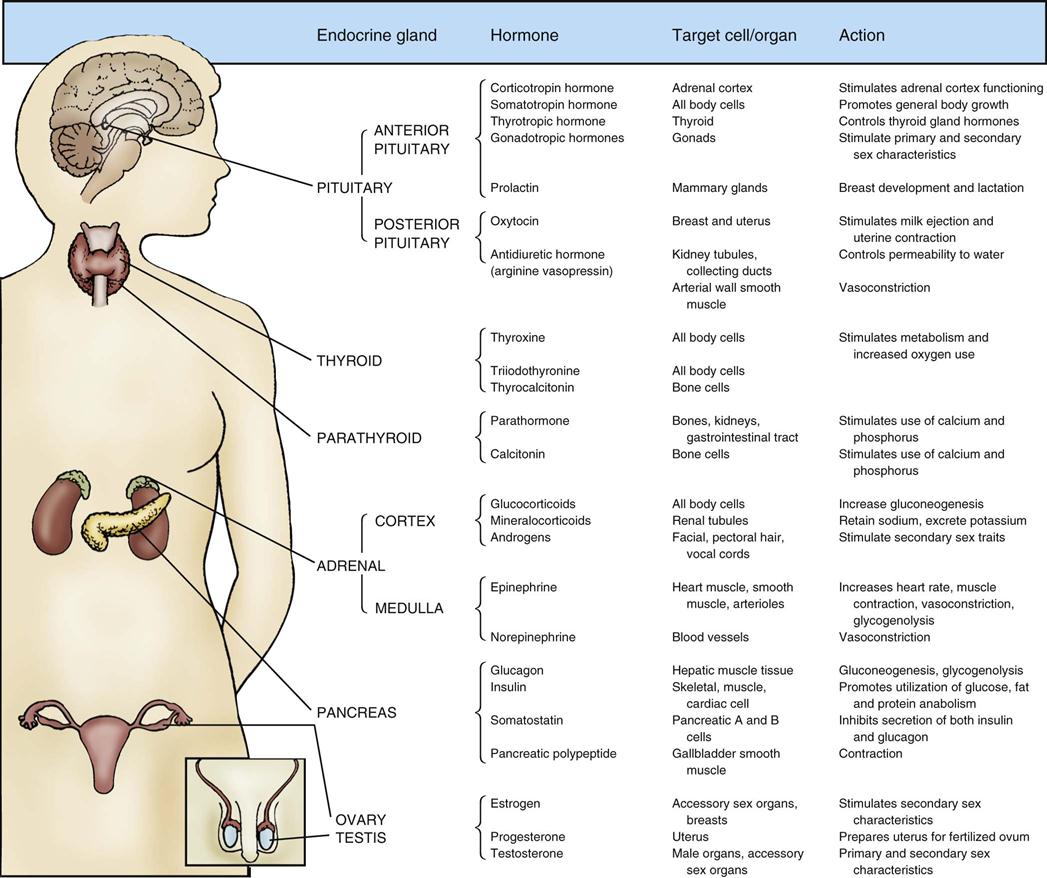Objectives
• Identify the components of an endocrine history.
• Describe clinical findings in patients with pancreatic and posterior pituitary dysfunction.
• Explain the clinical significance of laboratory and diagnostic tests of pancreatic dysfunction.
![]()
Be sure to check out the bonus material, including free self-assessment exercises, on the Evolve web site at http://evolve.elsevier.com/Urden/priorities/.
Assessment of the patient with endocrine dysfunction is a systematic process that incorporates the history and the physical examination. Most of the endocrine glands are deeply encased in the human body. Although the placement of the glands provides security, their inaccessibility limits clinical examination. The location of the endocrine glands, with the hormones they produce, target cells or organs, and hormonal actions, is presented in Figure 23-1. This chapter describes clinical and diagnostic evaluation of the pancreas and posterior pituitary gland.

History
The initial presentation of the patient determines the rapidity and direction of the interview. For a patient in acute distress, the history is curtailed to only a few questions about the patient’s chief complaint and precipitating events. For the patient without obvious distress, the endocrine history focuses on five areas: current health status, description of the current illness, medical history, general endocrine status, and family history.
Pancreas
Physical Assessment
Nursing priorities for physical assessment of the patient with pancreatic dysfunction focus on (1) hyperglycemia and (2) hypoglycemia.
Insulin, which is produced by the pancreas, is responsible for glucose metabolism. The clinical assessment provides information about pancreatic functioning. Hyperglycemia is the clinical manifestation of abnormal glucose metabolism.1,2 Patients with hyperglycemia may ultimately be diagnosed with type 1 or type 2 diabetes1,2 or be hyperglycemic in association with a severe critical illness.1,3 Hypoglycemia is often a complication of intensive insulin therapy. These conditions have specific identifying features as described in further detail in Chapter 24. Data collection for diabetic complications is outlined in Box 23-1.
Hyperglycemia
Because severe hyperglycemia affects a variety of body systems, all systems are assessed. The patient may complain of blurred vision, headache, weakness, fatigue, drowsiness, anorexia, nausea, and abdominal pain. On inspection, the patient has flushed skin, polyuria, polydipsia, vomiting, and evidence of dehydration. Progressive deterioration in the level of consciousness, from alert to lethargic or comatose, is observed as the hyperglycemia exacerbates. If ketoacidosis occurs, the patient’s breathing becomes deep and rapid (Kussmaul respirations), and the breath may have a fruity odor. Auscultation of the abdomen may reveal hypoactive bowel sounds. Palpation elicits abdominal tenderness. Percussion may reveal diminished deep tendon reflexes. Because hyperglycemia results in osmotic diuresis, the patient’s fluid volume status is assessed. Signs of dehydration include tachycardia, orthostatic hypotension, and poor skin turgor. The key laboratory tests that confirm the assessment of hyperglycemia are discussed under laboratory studies.
Hypoglycemia
Patients with hypoglycemia may experience symptoms of tiredness, extreme hunger, headache, dizziness or blurred vision. On inspection, the skin may be diaphoretic, cool and clammy, or sweaty. Hands may be shaky with decreased coordination. Deterioration in the level of consciousness, from alert to disorientated, lethargic to coma occur. Seizures can occur with hypoglycemia. Although hypoglycemia can be suspected from physical signs and symptoms, a blood glucose level, as described under laboratory studies, is required to confirm this suspicion.
Laboratory Studies
Pertinent laboratory tests for pancreatic function measure short-term and long-term blood glucose levels, which can identify and diagnose diabetes.
Blood Glucose
The fasting plasma glucose (FPG) level is assessed by a simple blood test after the person has not eaten for 8 hours.1 A normal FPG level is between 70 and 100 mg/dL.1 A fasting glucose level between 100 and 125 mg/dL identifies a person who is prediabetic. Even prediabetic individuals are at increased risk for complications of diabetes such as coronary heart disease and stroke. An FPG level of 126 mg/dL (7 mmol/L) or higher is diagnostic of diabetes (Table 23-1). In non-urgent settings, the test is repeated on another day to ensure the result is accurate. In a patient with classic symptoms of hyperglycemia as described above, a non-fasting blood glucose level above 200 mg/dL (11.1 mmol\L) suggests diabetes.1,2 After a meal, the concentration of glucose will increase in the bloodstream. Postprandial glucose levels should never exceed 180 mg/dL (10 mmol/L).4
TABLE 23-1
| PATIENT STATUS LEVEL | (mg/dL) |






